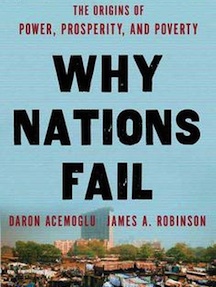By Fred H. Lawson
Institutionalist approaches currently dominate development economics. In order to explain why some economies exhibit sustained growth, whereas others remain stagnant or deteriorate, economists no longer point to societal factors, nor to the behaviors of powerful social classes or individual producers and consumers. They focus instead on the types of political institutions that govern economic activity—most importantly state agencies and foundational legal arrangements—as the source of profound divergences across economic outcomes.
Why Nations Fail neatly illustrates both the attractiveness and the pitfalls of institutionalist explanations for economic transformation. On the basis of a great many illustrative examples, Daron Acemoglu and James Robinson show that countries which for one reason or another came to possess political institutions that are inclusive and conducive to innovation, entrepreneurship, and investment have had much greater success over the past four centuries than ones whose regulatory structures promote the narrow interests of a small, grasping elite. The pattern holds just as firmly in sixteenth-century Latin America as it does in contemporary Sub-Saharan Africa, and fits the facts of seventeenth-century England just as closely as late twentieth-century Eastern Europe. Surely the authors are onto something useful.
Amidst all the details, readers might well lose track of the underlying theory. It seems to be the following: Political institutions like the Constitution of the United States of America block powerful interests from consolidating control over all aspects of society. Such institutions protect economic actors against government confiscation and profit-skimming, whether simply capricious or actually malevolent in nature. Over time, innovative products and processes are thereby allowed to generate new wealth, which provides the resources required for subsequent investment. By contrast, countries with rulers who routinely interfere with private wealth creation, or who divert its proceeds into the hands of themselves and their cronies, make sustained growth impossible, both by discouraging innovation and by scarfing up funds that might have been invested productively later on. There is also a nod to Joseph Schumpeter’s notion of economic growth as the “creative destruction” of entrenched ways of doing things, which can be effectively derailed if the classes and individuals who benefit from the existing order succeed in blocking institutional and procedural reform.
Fair enough. But to what extent do these remarks constitute an explanation, rather than a description, of economic change? The authors at times claim that the book demonstrates how significant transformations have taken place around the world, but also insist that they offer an account of why things have occurred as and when they did. The latter assertion implies that the study will spell out the circumstances and dynamics that led institutions of one type to take shape in some countries, whereas other types got established elsewhere. Few insights along these lines can be found in the text. The Spanish conquistadors are credited with creating the basic institutions that continue to govern many Latin American economies today—which seems a bit of a stretch. England, on the other hand, experienced the Glorious Revolution of 1688, and has found itself in fine fiddle ever since. Nineteenth-century Egypt might well have gone either way: The local economy had been severely damaged during the centuries of Ottoman domination. (Just how, exactly, the country suffered remains undisclosed, in line with conventional Egyptian nationalist historiography). Yet in 1805 Muhammad ‘Ali the Great took steps to energize agriculture, trade, and industry that could have put Egypt on a very different path, had not British imperialism intervened.
More recent cases receive similar treatment. Ethiopia had been ruled by an absolute monarch until 1974, when Emperor Haile Selassie was ousted by a group of military commanders known as the Derg. The new regime undertook a program of institutional restructuring, which consisted primarily of imposing state control over the extensive properties owned by the ruler and his closest allies. Partly in response, regional movements coalesced to fight for autonomy, in the face of which “the Derg itself started to disintegrate and split into factions.” Eventually the most ambitious and ruthless of the officers, Major Mengistu Haile Mariam, took charge of the central administration and adopted increasingly authoritarian practices of governance. More important, Mengistu started “enriching himself and his entourage just like Haile Selassie and other emperors before him had done.” As an explanation for this crucial sequence of events, Acemoglu and Robinson mention Robert Michels’s concept of the Iron Law of Oligarchy—despite the fact that this rule applies to well-established organizations, which Ethiopia in the late 1970s most decidedly was not—and Karl Marx’s aside “that history repeats itself—the first time as tragedy, the second time as farce.”
The turn away from conceptual analysis to historical narrative, essentially a Whig theory of economic growth, is striking in that such approaches now seem to command the field in economic history and development studies. Some clever academician is no doubt already busily at work formulating a critique of this brand of institutional analysis, which will recycle the contributions of Alexander Gerschenkron, Fernando Cardoso, Peter Evans, Robert Wade, and others whose ideas propelled investigations of economic transformation in earlier decades. In my opinion, the pendulum swing cannot happen soon enough.
Fred H. Lawson (ΦBK, Indiana University, 1973) is the Lynn T. White, Jr. Professor of Government at Mills College and a resident member of the Zeta of California chapter of Phi Beta Kappa.




